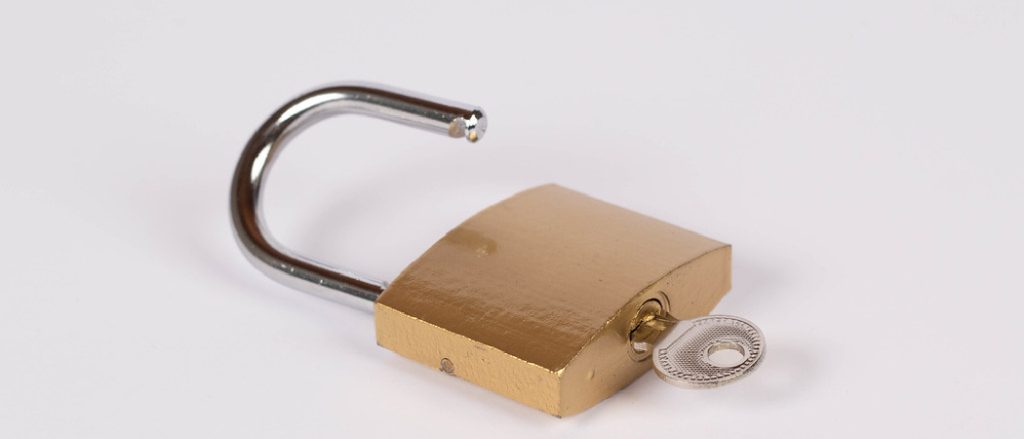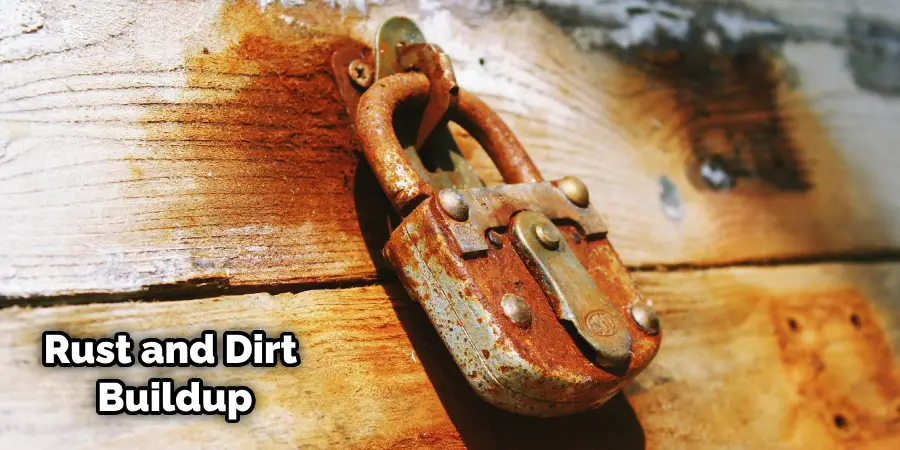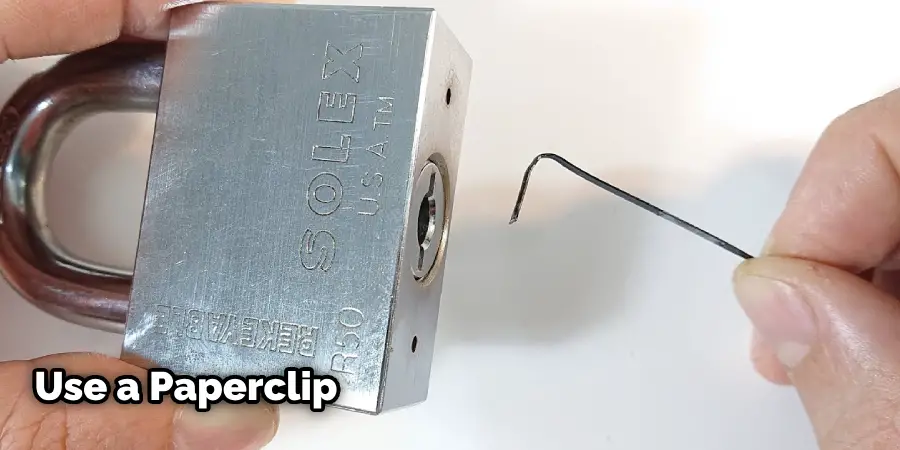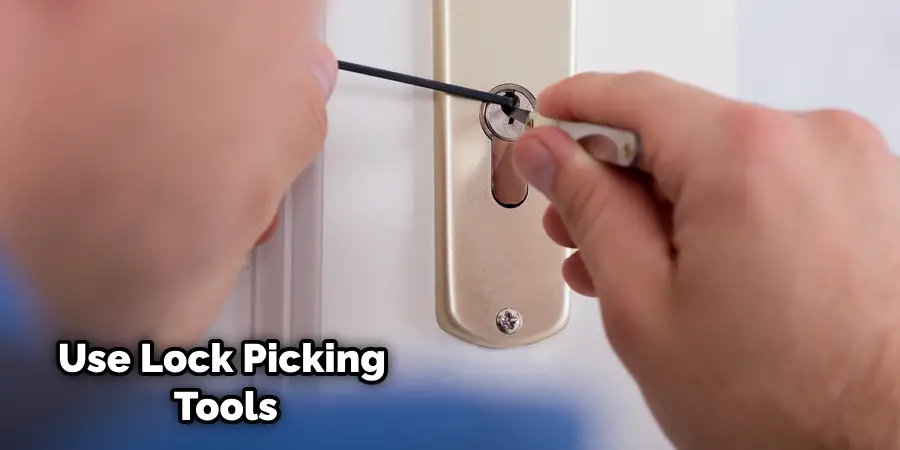Are you frustrated because you’ve been locked out of something and don’t have a key to open the padlock? While many consider cutting their padlocks the only solution, it’s not your only option! Believe it or not, several ways can open almost any type of padlock without having to damage it.

In this blog post, we will discuss some handy yet straightforward tricks and techniques that allow you to quickly unlock your locks without resorting to destruction. So please sit back, relax, and keep on reading to learn more about how to open a padlock without a key and without breaking it.
Understanding the Padlock
Before we delve into the techniques of opening a padlock without a key, it’s important to understand the basic components that make up a padlock.
The Basic Components of a Padlock
A padlock typically consists of three main parts: the shackle, the body, and the locking mechanism. The shackle is the U-shaped part of the lock that moves up and down, the body houses the locking mechanism, and the locking mechanism itself is a series of spring-loaded pins that move when the right key is inserted, allowing the shackle to be released.
Different Types of Padlocks and Their Mechanisms
There are several types of padlocks, each with their unique mechanisms. The most common types include combination locks, which require a specific sequence of numbers to be dialed for unlocking, and key-based locks, which use a key to manipulate the pins in the locking mechanism. Other types include disk detainer locks, which use rotating disks instead of pins, and tubular locks, which have a circular keyway and pins arranged in a circular pattern. Understanding the type of lock you’re dealing with is crucial in determining the right approach to unlock it without a key.
Common Reasons for Being Unable to Access a Padlock With A Key
Misplaced Keys
This is the most apparent reason for being unable to access a padlock with a key. It’s common for people to misplace their keys, especially if they don’t use them often.
Broken Key
Another common reason is a broken key. Over time, keys can become worn down or damaged, making it difficult or impossible to use to unlock a padlock.
Rust and Dirt Buildup

If you regularly use your padlock outdoors or in harsh environments, it’s common for rust and dirt to build up in the keyway. This can make it difficult to insert or turn the key, leading to frustration and difficulty when trying to open the padlock.
Tools and Materials You Will Need
Before diving into the techniques of unlocking a padlock without a key, it’s important to assemble the right tools. The specific tools will depend on the method you choose, but here are some common ones that can prove useful:
- Bobby Pins: These are incredibly versatile tools that can be bent into different shapes to manipulate the pins inside a lock.
- Lock Picking Set: A professional set includes various tools specifically designed to pick different types of locks.
- Paper Clips: Like bobby pins, paper clips can be bent and used to pick locks.
- Screwdriver: A small flat-head screwdriver can be used in certain ways to apply pressure to the locking mechanism.
- Tension Wrench: This is another specialized tool that can apply the right amount of tension to the lock while you manipulate the pins.
- Pen: A common pen can be used as a makeshift tool to unlock certain types of padlocks, specifically tubular locks.
- Lubricant: If the lock is rusty or jammed, a lubricant like WD-40 can help make the process smoother.
Remember, the goal is to open the lock without damaging it, so always use these tools carefully and responsibly. And most importantly, only use these techniques on locks that you legally own or are authorized to open.
How to Open a Padlock Without A Key and Without Breaking It: 9 Techniques
1. Use a Paperclip

One of the simplest and easiest ways to open a padlock without a key is by using a paperclip. Straighten out the paperclip and insert it into the bottom of the keyway, where you would normally insert the key. Then, start jiggling the paperclip up and down while turning it as if you were trying to turn a key. With some patience and practice, you should be able to manipulate the pins in the locking mechanism and open the padlock.
2. Try a Bobby Pin
Similar to a paperclip, a bobby pin can also be used to open a padlock without a key. Straighten it out and insert one end into the bottom of the keyway. Then, use the other end to apply pressure on the pins while jiggling it up and down. It may take a few tries, but you should be able to open the padlock with some persistence.
3. Use a Tension Wrench
If you have access to a tension wrench, this tool can also make opening a padlock without a key easier. Insert it into the bottom of the keyway and apply slight pressure in the direction you would turn a key. While keeping this tension, use your paperclip or bobby pin to manipulate the pins until they align, and the shackle can be released.
4. Try a Shim
A shim is a thin piece of metal that can be used to bypass the locking mechanism in a padlock. Insert it into the gap between the shackle and the body of the lock, and then use it to push down on the locking mechanism inside. With some practice, this method can be effective in opening certain types of padlocks.
5. Pick It with a Rake
If you have access to a lock-picking set, you can use the rake tool to quickly and easily manipulate the pins in the locking mechanism of a padlock. Please insert it into the bottom of the keyway and move it back and forth while applying slight pressure. This technique is known as raking and can be successful in opening many types of padlocks.
6. Use a Bump Key
A bump key is a specially cut key that can be used to bump the pins in a lock, allowing it to be opened without the correct key. If you have access to a bump key that matches your padlock’s brand and type, you can insert it into the keyway and tap on it with a hammer or similar object. This will cause the pins inside to jump and align, opening the lock.
7. Try a Decoding Tool
A decoding tool is a specialized device used to find the correct combination for a combination padlock. If you have one, follow the instructions on how to use it with your specific type of padlock to open it without breaking it.
8. Use Lock Picking Tools

For more advanced lock-picking, specialized lock-picking tools such as tension wrenches, picks, and extractors can be used. These tools require more skill and practice but can be effective in opening difficult padlocks without a key.
9. Seek Professional Help
If all else fails or you don’t feel confident in your abilities to open a padlock without a key, it’s best to seek professional help. A locksmith can use their expertise and specialized tools to spread the padlock without causing damage. This may be the best option if you need to access the padlock quickly or if it contains valuable items.
How to Avoid Common Mistakes While Opening a Padlock Without A Key and Without Breaking It
1. Using Too Much Force
It may be tempting to use a lot of force when attempting to open a padlock without a key, but this can actually cause more harm than good. Too much pressure or tension can damage the locking mechanism and make it even harder to open the lock.
2. Not Having the Right Tools
To successfully open a padlock without a key, it’s important to have the right tools. Using random objects or makeshift tools can lead to damaged locks and potential injury.
3. Not Being Patient
Opening a padlock without a key takes time, patience, and practice. It’s important not to rush the process or become frustrated if it doesn’t work on the first try.
4. Using These Techniques on Illegal Padlocks
It’s important to note that these techniques should only be used on locks that you legally own or have permission to open. Attempting to open someone else’s padlock without their consent is illegal and can result in consequences.
5. Damaging the Lock
The goal of opening a padlock without a key is to do so without causing any damage. If you notice that the lock is being damaged or becoming difficult to open, it’s best to stop and seek professional help.
Staying Safe and Legal While Picking Locks
While learning how to open a padlock without a key can be a useful skill, it’s important always to use these techniques responsibly and legally. Only use them on locks that you own or have been given permission to open, and never attempt to pick locks that are currently in use or belong to someone else. Always respect others’ property and privacy, and remember to use these techniques responsibly. Happy picking!
Legal and Ethical Carefulness
1. Laws Regarding Lock Picking
Lock-picking is a subject that falls into a legal gray area in many countries. In some places, owning and using lock-picking tools may be considered illegal without proper licensing or permission from law enforcement. It’s important to research the laws in your area before attempting to pick any locks.
2. Respect Others’ Property
It’s important never to attempt to pick a lock that belongs to someone else without their permission. Not only is this illegal, but it can also be considered unethical and a violation of privacy.
3. Use These Techniques Responsibly
While learning how to pick locks can be useful, it should never be used for illegal or malicious purposes. Always use these techniques responsibly and ethically to avoid causing harm or damage. Remember to only use these techniques on locks that you own or have permission to open. Respect others’ property and privacy, and do not use these techniques for illegal purposes.
4. Seek Professional Help
If you are unsure of the legality or ethics of attempting to pick a lock, it’s best to seek professional help from a locksmith. They have the proper expertise and tools to open locks without causing damage or violating any laws.
5. Only Use These Techniques as a Last Resort
While these techniques can be effective in opening padlocks without a key, they should only be used as a last resort. If you have other options available, such as obtaining the correct key or seeking professional help, it’s best to exhaust those options before attempting to pick a lock.
Advanced Techniques for Specific Padlock Types
1. Special Considerations for Combination Locks
Combination locks require a sequence of numbers for opening. A common technique for opening these locks involves using a metal shim or a thin piece of plastic to interfere with the locking mechanism while dialing the combination. Patience, precision, and a keen sense of touch are essential for this method.
2. Strategies for Opening Disk Detainer Locks
Disk detainer locks use a series of rotating discs instead of pins. To open these locks, insert a tension tool and a pick into the keyway. Apply slight pressure with the tension tool while manipulating the disks with the pick. Once all the disks are aligned, the lock should open.
3. Tips for Dealing with Tubular Locks
Tubular locks are often found on bikes and vending machines. These locks can be picked using a tubular lock pick, which has several pins that can be adjusted to match the lock’s pin configuration. The lock pick is inserted into the lock and gently turned until the lock opens.
4. Using Decoding Tools for Combination Padlocks
Decoding tools for combination locks are designed to find the correct combination without knowing it beforehand. These tools use a hook that lifts the wheels inside the lock one at a time. As each wheel is lifted, the tool measures the resistance to determine the correct number for each wheel in the combination. As with other lock-picking techniques, the use of decoding tools requires patience and practice.
Lock Maintenance and Care
Preserving the longevity and maintaining the performance of your padlocks involves regular care and attention. Here are a few essential tips to consider.
1. Tips for Maintaining the Longevity of Padlocks
To extend the lifespan of your padlocks, remember to store them in a dry, clean environment when not in use. Exposure to moisture and dirt can lead to rusting and deterioration of the lock mechanism. Additionally, avoid dropping the padlocks or using inappropriate force when unlocking, as this can lead to internal damage.
2. Cleaning and Lubricating Padlocks for Optimal Performance
Cleaning your padlocks is a crucial part of maintenance. Use a can of compressed air to remove dirt and dust from the keyhole. Then, apply a lubricant specially designed for locks; this helps to keep the internal mechanism functioning smoothly. Remember to lubricate your padlocks regularly, especially if they are used in a harsh environment.
3. Avoiding Common Mistakes That May Lead to Lock Damage
Please avoid the use of heavy, oily lubricants as they can attract dust and grime, leading to clogging of the lock mechanism. Do not attempt to force a key into a lock, as this can damage both the key and the lock. Lastly, avoid exposing your padlocks to corrosive substances or extreme temperature changes, both of which can degrade the lock’s material and impair its functionality.
Conclusion
In conclusion, opening a padlock without a key is a skill that can come in handy in various situations. From paper clips to professional pick locks, there are multiple methods that you can use.
However, it’s critical to remember that these techniques should only be used responsibly and on locks that you own or have explicit permission to open. Patience, the right tools, and a meticulous approach are all crucial to successfully unlocking a padlock without causing any damage.
Lastly, if you find yourself unable to unlock a padlock or if it contains valuable items, don’t hesitate to call in a professional locksmith. Safe and legal lock picking is a balance of skill, common sense, and respect for private property. Thanks for reading this article about how to open a padlock without a key and without breaking it.

